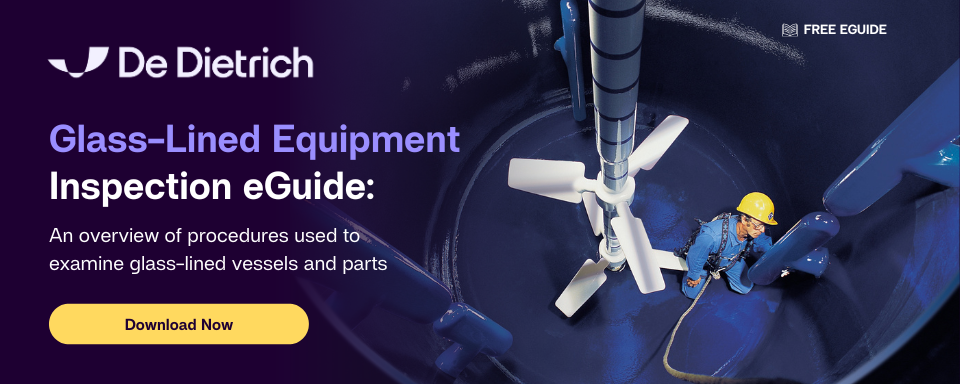Top 5 Tips for Keeping your Glass-Lined Equipment in Good Shape
 It’s no secret that staying in shape takes a considerable amount of effort. In addition to the mental commitment, you have to find the time and energy on a daily basis to squeeze in workouts in between work, family and personal time. And that’s on top of eating right, getting plenty of rest, staying hydrated, and so on. These can be difficult tasks to keep up with, especially for the long term, but many people manage to persevere and not succumb to the couch with a bag of chips. Why? There are many different reasons, but overall, leading a healthier lifestyle makes you look better, feel better, and increases your quality of life.
It’s no secret that staying in shape takes a considerable amount of effort. In addition to the mental commitment, you have to find the time and energy on a daily basis to squeeze in workouts in between work, family and personal time. And that’s on top of eating right, getting plenty of rest, staying hydrated, and so on. These can be difficult tasks to keep up with, especially for the long term, but many people manage to persevere and not succumb to the couch with a bag of chips. Why? There are many different reasons, but overall, leading a healthier lifestyle makes you look better, feel better, and increases your quality of life.
You know that glass-lined vessel that hangs out in your facility? That 10,000 lbs. (give or take a few thousand pounds) workhorse that has provided years of continuous service to your process? With respect to health and fitness, it’s not all that different from you. Of course it’s not a living being and doesn’t have blood pumping through its piping like you do, but metaphorically speaking it is the heart of a reaction process and the better you care for it the better and longer it will perform for you. We’ve identified the top five tips for keeping your vessel in good shape to help ensure it lives a long, healthy life.
1. To avoid agitator problems, do not operate with liquids at the blade level
When the agitator is run with the fluid in the vessel at or below the blade level, fluid flow causes the shaft to “skate”, resulting in excessive stresses and runout in the seal area and upper end of the agitator. This can cause premature seal failure and even glass damage on the agitator itself. The simple fix is to make sure there is the right volume of product in your vessel before turning on the agitator. If this becomes a regular problem, then it’s time to look into get a different sized reactor to meet your process needs. For more information on agitation best practices, read our post on Agitation Best Practices for Improved Mixing.
2. Establish a preventative maintenance program for your vessel
The main principle behind a productive preventative maintenance program is a meaningful inspection schedule during which:
- an accurate estimate of the vessel service life can be established
- the cause, effect, and cure sequence for damage analysis can be determined at the early stage
- repairs, when needed, can be made (which will usually be smaller and more reliable)
The minor amount of downtime your process will experience is far outweighed by the benefits of establishing a program. But how often should a routine vessel inspection be conducted? The frequency of maintenance inspections varies from several times per year to once every couple of years depending upon the severity of service, or until an accurate service record is established. The following chart can be used to reference the frequency based on the specifications of your equipment:
|
Type of Equipment |
Inspection Frequency |
|
Storage Tanks |
3 to 5 years |
|
Vessels with agitators |
Annually |
|
Vessels without agitators |
1-2 years |
|
Repaired equipment: Plugs 1 inch or smaller |
After 1 month, 6 months, then annually |
|
Repaired equipment: Plugs >1 inch |
After 1 month, 3 months, 6 months, then annually |
|
Equipment that undergoes service changes |
After each service until a history is established then at a frequency dependent on the service. |
A typical five-step inspection procedure includes visual observations, glass thickness measurement, electric testing, marking and mapping, and record keeping. For more details on inspection procedures, check out our blog post, A Step-by-Step Guide to Glass-Lined Equipment Inspection.
3. Use only approved tools when working inside glass-lined vessels
Obtaining hand samples through the manway, scraping product build-up off vessel walls, and cleaning debris around the bottom outlet nozzle are all examples of regularly scheduled services and tests that your vessel may go through on a regular basis. As quick and careful as you may be, it is always safest to use products that won’t damage the glass lining. Therefore it is best to avoid glass or metallic instruments during operation or maintenance of the vessel; Plastic and PTFE-lined tools are the way to go. Here’s a link to a previous post we published entitled Tips for Working Inside Glass-Lined Equipment for additional guidelines.
4. Follow operating guidelines for pressure and temperature limits
Knowing these limitations is crucial to safely and efficiently using your equipment. The design limits are clearly stamped on the nameplate of each vessel and should never be operated to exceed those limits. It is important to also keep in mind that various accessories installed, such as mechanical seals, valves, sight glasses, etc. must be considered when determining the maximum pressure and temperature operation parameters. If their limits are less than that of the vessel then it will restrict the vessel operation ranges.
One thing to especially watch out for when operating your vessel is thermal shock, as this can cause an immediate loss of the integrity of the internal glass lining. Thermal shock to the glass lining can occur when the recommended safe temperature differential is exceeded. Read more about how to keep your vessel safe from thermal shock and review our chart that details the maximum allowable temperature changes.
5. Follow vendor guidelines for rigging and handling vessels
The proper care and handling of glass-lined reactors, tanks and accessories is of vital importance to anyone who operates or maintains such equipment. When contractors or plant personnel install glass-lined equipment, certain precautions should be observed during the unloading, rigging and transferring of the vessel. For a list of those precautions as well as some tips for properly handling glass-lined vessels read this post.
Just as your doctor would convey to you how diet and exercise are an essential part of living a healthy lifestyle, we are telling you it’s important to take good care of your vessel. The extra time and effort that you put into routine service and maintenance along with being sure to adhere to operating and mixing guidelines will extend the life of your vessel and maximize the efficiency of your process. Download our new Glass-Lined Equipment Inspection eGuide to find out more about the inspection process and what you can do to keep your vessel in good shape.
Want to know about some other ways to optimize your vessel’s performance? Read our new eBook, Optimizing the Glass-Lined Reactor, filled with details on enhancements that can be added to your new or existing vessel to upgrade it to the next level.

